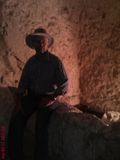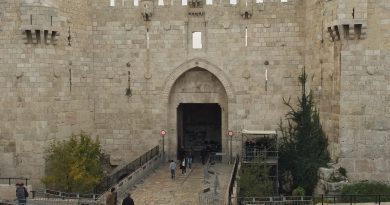The Tomb of Yehuda HaNasi
 In the northern part of Israel, one can visit the tombs / graves for many of our most important and most famous rabbis.
In the northern part of Israel, one can visit the tombs / graves for many of our most important and most famous rabbis.
At most of these tombs you will find separate entrances for men and women, places to pray. Usually you will see people there saying prayers or reciting psalms. There is often a beit midrash (study hall) on site. I've been to several of these places — Rambam (Maimonides), Honi Hamaagal ("the circle maker), and the biggest and best known, Shimon Bar Yochai's tomb in Meron.
Yesterday we visited the tomb of Yehuda Hanasi in Beit Shearim. I'm disappointed by the lack of attention paid to Yehuda Hanasi. There was pretty much on one at his tomb other than tourists. He is a far more important figure historically than many lesser rabbis who have much bigger crowds learning and praying at the tombs.
Yehuda Hanasi was the editor of the Mishnah. In the early 3rd century, around 200-220, he took all of the oral teachings that were circulating then as "Torah sh'ba'al peh," the Orah Torah, and he selected among competing versions of teachings and organized them into the form we know as the Mishnah. The Mishnah, in turn, went on to become the basis for both the Palestinian and Babylonian Talmuds. If it were not for the work of Yehuda Hanasi, the path forward for Jewish learning would have been very different indeed. The Talmud as we know it may never have come into existence. Who knows what could have happened to Jewish learning ?
In the picture at right, I am sitting on a low stone wall. Behind me, as near as we can tell, is the final resting place of Yehuda Hanasi and his wife. The dirt covered graves carved into the bedrock are right there, which is in accord with his instructions that he wanted to be buried in earth, not just placed in a sarcophagus.
Why the lack of attention? Where are the people praying, studying, reciting psalms?
I suspect the lack of attention for Yehuda Hanasi has something to do with the fact that his tomb is in an area designated as a national park. Maybe the authorities aren't allowing religious groups to set up some kind of facility there.
I find it rather sad. If Honi the Circle Maker — a minor, but colorful character in the Talmud — deserves a living facility with people there praying, reciting psalms, studying, etc. — surely Yehuda Hanasi deserves the same.



Next time you go to one of those sites. Please say a prayer for me 🙂
I believe the gravesite in Tzipori is where people go to to pray and for the rabbi’s memorial. He passed away in Tzipori.
I write this in his hillula anniversary of the elevation of his soul….
We just did a night study and our teacher was saying he rests in tzipori: yet reading the info on Beit shearim it seems more logical that he rests there with his wife, resting in the ground and not in stone sarcophagi. They say he elevated his soul in tzipori and rests in Beit shearim.
I know there is a sarcophagus in tzipori… And I see many go there for the hillula, but it feels more right to me that he is with his wife in beit shearim.
Why is there a sarcophagus in tzipori?
Your thoughts?
By his merit may hashem protect us… ️